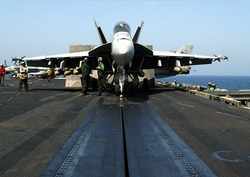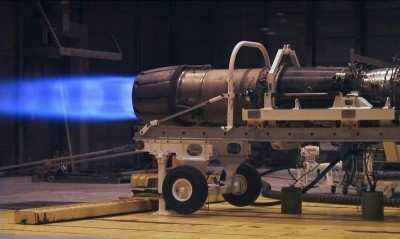First Indication Is That Navy Hornet Can Fly on 'Green
Fuel'
The Navy says it is one step closer to flying the "Green
Hornet." Members of the NAVAIR Fuels team recently made a small,
but very vital step toward changing the source of jet fuel the U.S.
Navy uses.

File Photo
The team tested an F404 F/A-18 engine to determine if it could
run on a jet fuel (JP-5) derived from a weed.
"This engine run was our first shot at certifying a JP-5 fuel
derived from a renewable source," said Tony Cifone, director for
the Propulsion & Power Department at the Naval Air Systems
Command. "This is the first step on the road to the 'Green
Hornet'."
The "Green Hornet" encompasses more than just a new source for
jet fuel. It will eventually include upgrades and new technology to
create a more fuel efficient F/A-18 Super Hornet. More tests will
occur in the December-January timeframe on the F414, the engine for
the Super Hornet. This test could be conducted either at NAS
Patuxent River or at the General Electric facility in Lynn,
Massachusetts.
Secretary of the Navy Ray Mabus pointed out during the Navy's
Energy Forum held last week, that the "Green Hornet" is an
important element in accomplishing his five Green Goals, which
center around reducing the use of petroleum derived fuels and
increasing the use of energy from renewable sources. The intent is
to have the alternative fuels in operational use in the Hornet
within three years of certification.
This first test on the F/A-18 Hornet engine proved that a
renewable source of JP-5 can be used as a "drop-in" replacement for
the current petroleum-based jet fuel. "The engine reacted the way
we had expected," said NAVAIR's Rick Kamin, who is the Navy's Fuel
Team Lead. "It did not know the difference." Likewise, the
operators in the fleet will not know the difference, Kamin said as
he emphasized the importance of the "drop-in" aspect of an
alternative fuel.
Cifone said he anticipates the first actual flight of a Super
Hornet fueled with a renewable fuel blended with the current JP-5
will occur next spring. "The eventual goal for the Navy is to be
able to use fuels produced from non-petroleum sources without
having to blend them with petroleum derived fuels," Kamin
explained. "The 50/50 blend is a stepping stone on the path. We are
using a walk before you run philosophy.

"Aircraft, since their inception, have been developed around
petroleum based fuels. Although renewable fuels currently being
tested have many similar properties to petroleum based fuels, they
are not 100 percent the same. Blending is the near term solution to
allow use of these fuels until on-going research provides a
complete solution."
The tests the fuels team conducts to ultimately certify
alternative fuels are the same for all fuels. The tests encompass
standard chemistry, component and engine testing. The certification
process is the same regardless of the source of the fuel. One of
the unknown aspects of using a fuel derived from a non-petroleum
source is how it would affect seals in the various systems.
Standard petroleum-based jet fuel contains aromatics, a class of
ring-shaped hydrocarbon molecules that includes benzene and related
solvents. Aromatics soak into the seals and make them swell, and
ensure a tight fit against the metal. "Self-sealing fuel bladders,
for example," Kamin said, "need aromatics to work properly."
The fuel used in the recent run of tests was created from the
camelina plant, which is in the same family of plants as the
mustard seed and rapeseed. It needs little water or nitrogen to
flourish and can be grown on marginal agricultural soil. An
important aspect of using camelina as a renewable source for fuel
is that it does not compete with food crops.
Kamin said the Navy's goal is to certify as many alternative
fuels derived from renewable sources as possible.
 Aero-News: Quote of the Day (10.27.25)
Aero-News: Quote of the Day (10.27.25) ANN's Daily Aero-Linx (10.27.25)
ANN's Daily Aero-Linx (10.27.25) NTSB Prelim: Lancair 320
NTSB Prelim: Lancair 320 Airborne Programming Continues Serving SportAv With 'Airborne-Affordable Flyers'
Airborne Programming Continues Serving SportAv With 'Airborne-Affordable Flyers' Airborne-Flight Training 10.23.25: PanAm Back?, Spirit Cuts, Affordable Expo
Airborne-Flight Training 10.23.25: PanAm Back?, Spirit Cuts, Affordable Expo




